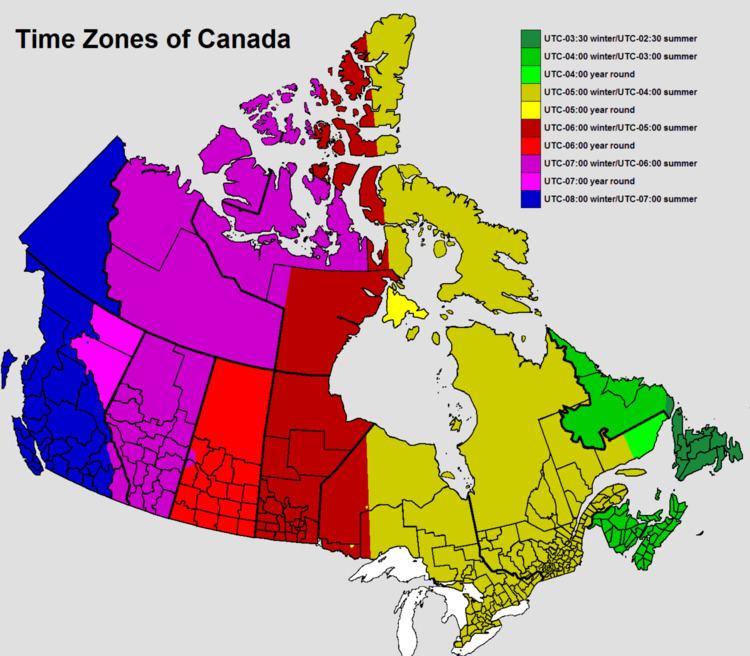Canada is divided into six time zones, based on proposals by Scottish Canadian railway engineer Sir Sandford Fleming, who helped pioneer the world's time zone system. Most of Canada operates on standard time from the first Sunday in November to the second Sunday in March and daylight saving time the rest of the year.
Pacific Standard Time PST UTC−08:00 and Pacific Daylight Time PDT UTC−07:00British Columbia (most of the province)Yukon Pacific Standard Time PST UTC−08:00 year-roundNorthwest TerritoriesTungsten and the associated Cantung MineMountain Standard Time MST UTC−07:00 year-roundBritish Columbia, northeasternNorthern Rockies Regional Municipalitymost of Peace River Regional District (except Fort Ware), including Dawson CreekBritish Columbia, southeasternCrestonMountain Standard Time MST UTC−07:00 and Mountain Daylight Time MDT UTC−06:00AlbertaBritish Columbia, southeasternColumbia-Shuswap Regional District east of the Selkirk MountainsRegional District of East KootenayRegional District of Central Kootenay east of the Kootenay River and parts east of Kootenay Lake that are south of and including Riondel (but not Creston)Northwest Territories, except for Tungsten (see above), two fishing lodges in the southeast and a mine site in the southwestNunavut (see time in Nunavut)west of 102° West, andall communities in the Kitikmeot RegionSaskatchewan (see time in Saskatchewan)Lloydminster and surrounding area (the municipal government chose to unify the entire city with Alberta's time zone.)Central Standard Time CST UTC−06:00 and Central Daylight Time CDT UTC−05:00ManitobaSaskatchewanCreighton (unofficial)Nunavutbetween 85° West and 102° West, andResolute plus all communities in the Kivalliq Region and the west shore of Hudson Bay except Southampton Island (Coral Harbour)Ontario, northwesternwest of 90° West (except the Atikokan, New Osnaburgh and Pickle Lake areas, and the Shebandowan and Upsala areas)east of 90° West: Big Trout Lake areaCentral Standard Time CST UTC−06:00 year-round (no DST)Saskatchewan (most of the province) (see Lloydminster, and Creighton, above)Eastern Standard Time EST UTC−05:00 and Eastern Daylight Time EDT UTC−04:00Nunavuteast of 85° West, andall communities in the Qikiqtaaluk Region except ResoluteOntarioeast of 90° West (except the Big Trout Lake area), pluswest of 90° West: Shebandowan and Upsala areasQuebec (most of province)Areas of Labrador adjacent to Schefferville (in Quebec but very close to the Labrador border) use EST and DST unofficially.Eastern Standard Time EST UTC−05:00 year-round (no DST)Nunavutentire Southampton Island (Coral Harbour)Ontariowest of 90° West: Atikokan area and New Osnaburgh/Pickle Lake areaAtlantic Standard Time AST UTC−04:00 year-round (no DST)Quebec (east of the Natashquan River)Atlantic Standard Time AST UTC−04:00 and Atlantic Daylight Time ADT UTC−03:00Labrador (all but the southeastern tip)New BrunswickNova ScotiaPrince Edward IslandQuebec (Magdalen Islands and Listuguj Mi'gmaq First Nation)Newfoundland Time Zone
Newfoundland Standard Time NST UTC−03:30 and Newfoundland Daylight Time NDT UTC−02:30Labrador (southeastern)NewfoundlandThe Yukon Time Zone (UTC−09:00) covered Yukon until 1975. In 1983, the zone (then covering only a small portion of Alaska) was restructured to cover most of Alaska and renamed the Alaska Time Zone.In 1988, Newfoundland and Labrador used "double daylight savings time" from April 3 until October 30, meaning that the time was set ahead by 2 hours. Most of Labrador, which uses Atlantic Standard Time (UTC-4) used UTC-2 for this time period. All of Newfoundland and southern Labrador, which uses UTC-3:30 as its standard time zone, used UTC-1:30. This only happened in 1988 and the province now only adjusts its time by one hour for daylight savings time.Four Canadian cities, by local ordinance, used Daylight Saving Time in 1916. Brandon, Manitoba on April 17 became the first place in the world to use it. It was followed by Winnipeg on April 23, Halifax on April 30, and Hamilton, Ontario on June 4.
Daylight saving time is now observed in most regions of all provinces and territories, except Saskatchewan (although, since Saskatchewan is in the Mountain Time Zone and observes CST time it is effectively on DST year round). Under the Constitution of Canada, laws related to timekeeping are a purely provincial matter. In practice, since the late 1960s DST across Canada has been closely or completely synchronized with its observance in the United States to promote consistent economic and social interaction. When the United States extended DST in 1987 to the first Sunday in April, all DST-observing Canadian provinces followed suit to mimic the change.
The latest United States change (Energy Policy Act of 2005), adding parts of March and November starting in 2007, was adopted by the various provinces and territories on the following dates:
Ontario, Manitoba – October 20, 2005Quebec – December 5, 2005Prince Edward Island – December 6, 2005New Brunswick – December 23, 2005Alberta – February 2, 2006Northwest Territories – March 4, 2006British Columbia – March 31, 2006Nova Scotia – April 25, 2006Yukon – July 14, 2006Newfoundland and Labrador – November 20, 2006, but officially announced on January 18, 2007Nunavut – February 19, 2007Saskatchewan – no official action taken, as the province does not change their clocks to summer time (they remain on CST all year round)Data for Canada from zone.tab of the IANA time zone database. Columns marked with * are the columns from zone.tab itself.

